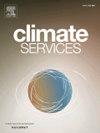Effect of climate change and variability-induced shocks and stresses on rural household livelihoods and their adaptation practices in West Arsi Zone, South-Central Ethiopia
IF 4
3区 环境科学与生态学
Q2 ENVIRONMENTAL SCIENCES
引用次数: 0
Abstract
This study aimed to evaluate the effects of climatic trends and variability on main livelihood practices (crop production), as well as farmers’ perceptions and adaptation to local climate change in West Arsi zone. The data gathered from 354 of the 364 sample households who took part in the survey in six Kebeles utilizing a standardized questionnaire served as the basis for this investigation. Ten surveys with incomplete responses were removed from the data analysis after the responses were reviewed for completeness across all questionnaire sections. Key informant interviews, focus groups, meteorological data from the Ethiopian Meteorological Institute, crop and aid beneficiary data from the West Arsi zone Bureau of Agriculture and Office for Disaster Risk Management were also used in the study. The Mann–Kendall statistical test was used to analyze climate trends. The descriptive and multivariate statistical models in SPSS v.25 and Ms Excel soft wares were used to analyze data. The results indicated significant increase in aggregated mean annual temperature (p < 0.001) by 0.045 °C per year and annual rainfall showed significant decrease (p < 0.1) by 3.7 mm per year in the study area, over the period 1983 to 2019. The results indicates annual rainfall was a significant predictor of crop production (t = 15.24, p < 0.05), and revealed a significant differences in household adaptation practices (p < 0.001) between agro ecological zones. The study also revealed that household demographic and socio-economic factors significantly influenced their adaptation choices, highlighting the need for further research on interventions that enhance local adaptation strategies.
求助全文
约1分钟内获得全文
求助全文
来源期刊

Climate Services
Multiple-
CiteScore
5.30
自引率
15.60%
发文量
62
期刊介绍:
The journal Climate Services publishes research with a focus on science-based and user-specific climate information underpinning climate services, ultimately to assist society to adapt to climate change. Climate Services brings science and practice closer together. The journal addresses both researchers in the field of climate service research, and stakeholders and practitioners interested in or already applying climate services. It serves as a means of communication, dialogue and exchange between researchers and stakeholders. Climate services pioneers novel research areas that directly refer to how climate information can be applied in methodologies and tools for adaptation to climate change. It publishes best practice examples, case studies as well as theories, methods and data analysis with a clear connection to climate services. The focus of the published work is often multi-disciplinary, case-specific, tailored to specific sectors and strongly application-oriented. To offer a suitable outlet for such studies, Climate Services journal introduced a new section in the research article type. The research article contains a classical scientific part as well as a section with easily understandable practical implications for policy makers and practitioners. The journal''s focus is on the use and usability of climate information for adaptation purposes underpinning climate services.
 求助内容:
求助内容: 应助结果提醒方式:
应助结果提醒方式:


